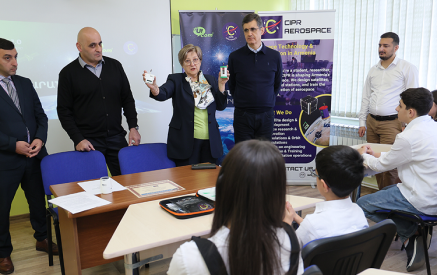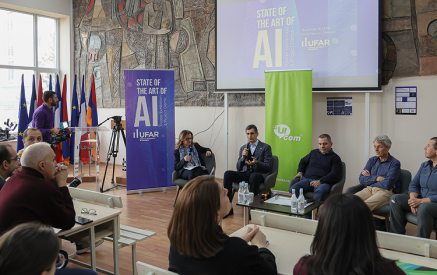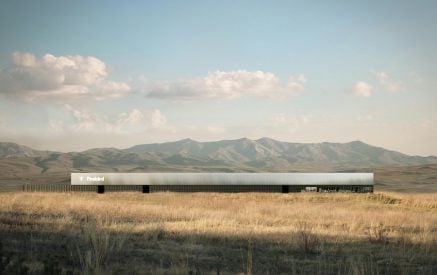In recent news, Firebird, a cloud AI company, is planning to open a new 100MW AI data center in Armenia in 2026. Thousands of Nvidia Blackwell GPUs will be employed, in an endeavour to cultivate Armenia’s “tech sector and global partnerships” and “unlock new opportunities for innovation and economic growth across the region.” [1]
This is a major step for Armenia — a promising partnership with one of the biggest players of the tech landscape, a leap towards the West, job creation, and investment in local infrastructure. However, the enthusiastic headlines are missing one crucial element of this undertaking — its potential environmental impact. Officials tout this as a leap towards innovation, job creation, and an investment in Armenia’s future as a tech hub, but beneath the celebration lie complex environmental, social, infrastructural, and geopolitical questions.
What Is a 100MW AI Data Center?
An AI data center is a facility that houses the specific IT infrastructure needed to train, deploy, and deliver AI applications and services. AI data centers require high-performance GPUs and advanced storage, energy, and cooling infrastructure. The size of an AI data center depends on its energy draw. According to industry benchmarks, a 100 MW hyperscale data center typically needs at least 100,000 m²—often upwards of 150,000–200,000 m²—to accommodate server halls, cooling plants, backup generators, and support infrastructure. For instance, Chicago’s Lakeside Center uses 102,000 m² for 100 MW, and Google’s Iowa campus spans nearly 186,000 m² at a similar capacity. [2] [3]
AI models such as OpenAI’s GPT-4 can contain hundreds of billions of parameters. These models require immense computational resources, both during training and when they are fine-tuned for specific tasks. Even after deployment, supporting millions of user queries in real time demands continuous energy input. This makes AI infrastructure particularly energy-intensive compared to traditional computing workloads. According to Armenia’s Minister of High-Tech Industry Mkhitar Hayrapetyan, the new data center will ”enable the delivery of AI computing cloud services to both Armenia’s economy and tech companies worldwide focused on innovation.”[4] Hayrapetyan also stated that “several major companies have already expressed interest in the AI factory’s cloud services.” This means that the physical hardware behind the cloud, positioned in Armenia, will place enormous energy demands on local infrastructure.
Read also
An Overburdened Energy Grid
These systems require enormous electricity, specialised hardware, and constant cooling. According to the Telegram page Economy of Armenia, the general director of Team Group, one of the parties involved in the project, the center will use 2,5-3% of Armenia’s electricity demand. For scale, a large hyperscale data center with a power demand of 100MW and more has an annual electricity consumption equivalent to that of 350 000 to 400 000 electric cars.[5]
This facility could be a major strain on Armenia’s power grid, and this could be exacerbated by the commonly occurring mismatch between the quick timelines of construction and frequently lethargic expansion and strengthening of energy grids. According to ArmStat’s 2023 Energy Press Release, Armenia’s energy mix remains heavily fossil-dependent, with 58.4% derived from natural gas, 18.3% from nuclear power, and 16.9% from oil. Branded as a “cleaner” fossil fuel, natural gas comes with an often-overlooked cost: methane leaks from pipelines, which unleash a gas that traps 86 times more heat than carbon dioxide over the span of 20 years.[6] Methane also degrades air quality by contributing to the formation of tropospheric ozone — a pollutant linked to approximately 1 million premature deaths worldwide each year from respiratory diseases.[7] Additionally, building the infrastructure to transport gas can cause habitat fragmentation and loss of biodiversity, and leaks from pipes can pollute groundwater. [8]
The Air We Breathe
Without technical specifics, we are left to infer from the global patterns established by similar facilities; and those patterns are far from reassuring. According to the Business Insider, these complexes install diesel backup generators which emit “volatile organic compounds, nitrous oxides, sulfur dioxides, and particulate matter — all regulated air pollutants the EPA labels as hazardous to human health.”[9] Furthermore, per Business Insider’s estimations, air pollutants emitted by data centers across the US could trigger “nearly 20,000 asthma symptom cases a year and create a $385 million annual burden on public health.”
As reported by the World Bank Group, Armenia “ranks among the lowest in Europe in terms of air quality,” and generator pollution is more harmful to communities that are already suffering from high levels of air pollution. As reported by the World Health Organization, a staggering 16% of deaths from stroke and ischaemic heart diseases in Armenia are caused by air pollution.[10] As a country with an economy “highly energy-intensive” and “reliant on fossil fuels”, it is misleading of the government and of the media to frame the data center solely in terms of economic benefit, while neglecting its potential environmental and public health costs. [11]
Water: The Hidden Cost of Cloud Computing
The Guardian[12] has compiled a map of 632 data centers, either active or under development, owned by Amazon, Microsoft, and Google. The map demonstrates a large number of data centers built in areas with water scarcity. Microsoft reported that 42% of its water was obtained from “areas with water stress”. This number was also cited by Business Insider, who mapped location information from permits onto the Aquaduct Water Risk Atlas and found that “40% of data centers were sited in areas of high or extremely high water stress.”[13] Upon requesting for facility-specific water use, Business Insider was sued by utility agencies to hinder the release of metered water use records. Should this give the residents of Armenia optimism and hope that the new facility will be transparent with their accounting of water use?
MIT News estimates that “for each kilowatt hour of energy a data center consumes, it would need two litres of chilled water for cooling.” Complementing this, reporting from Mongabay[14] and research by the University of Tulsa[15] reveal that many data centers rely on potable water for this purpose: a practice driven by the cost-efficiency of drinking water and, conveniently, the fact that “microorganisms are routinely eliminated from public drinking water.”
Lessons from Abroad
Around the world, communities have pushed back against the construction of data centers in their regions. In Cerrillos, Chile, residents voted in a referendum to prevent the construction of a Google server farm[16]. In Zeewolde, Netherlands, public opposition successfully halted Meta’s construction plans.[17] Meanwhile, mounting environmental scrutiny has led Microsoft to pause data center investments in Indonesia, the United States, and the United Kingdom.[18]
The parties promoting this high-profile initiative either overlook or deliberately omit the broader environmental implications of the data center’s arrival. Numerous case studies underscore the severe ecological and social consequences of such developments. In Aragón, Spain, for instance, Amazon’s three proposed data centers have been licensed to extract 755,720 cubic metres of water annually, which is enough to irrigate 233 hectares of corn. These facilities are projected to use more electricity than the entire region combined. In a country where 75% of the land is already at risk of desertification, and where heat-related deaths are on the rise due to climate change, such a project is not merely a red flag, but a cautionary tale. Data centers should not be constructed in regions already vulnerable to climate extremes. Despite public commitments to sustainability, tech companies often prioritize scale and speed over local environmental concerns, especially when operating in regions with weak oversight or public resistance.
Accountability and Transparency
In 2023, Google reported that 78% of its global water use came from potable sources.[19] While tech giants such as Microsoft and Google have pledged to employ water offsetting to become “water positive”, water offsetting does not behave the same way as carbon offsetting – how can we guarantee that those companies will offset water in the same drought-stricken place it takes that water from? This narrative often veers into greenwashing. Without transparent, location-specific accounting, such pledges raise questions about whether these are symbolic gestures rather than enforceable commitments.
Business Insider also discovered that some of the largest data center facilities were permitted to use more water in a day than an estimated 49,000 Americans. In Armenia, droughts occur almost annually, lasting longer and becoming more severe. The drought zone is also expanding into higher mountainous areas and beginning earlier in the year.[20] According to the United Nations Development Program, Armenia’s water sector, while having sufficient water resources, faces poor management and climate change-caused challenges.[21] According to the World Bank Group, the over-extraction of the Ararat Valley and Lake Sevan is threatening our agriculture and drinking supplies. A quarter of all jobs in Armenia are in the agriculture sector, and water is essential for the production of hydropower and mineral production, which accounts for more than a third of all exports.
Bearing in mind the extensive evidence on data centers’ water consumption and the current state of water services in Armenia, it would be deeply irresponsible to overlook the risks this new facility could pose to agriculture, irrigation, and public health, particularly for those most vulnerable to extreme heat. Climate change alone is projected to shrink the economy by 3% by 2060 and worsen poverty by 2.7 percentage points by 2030 due to its impact on water agriculture.[22] The summer of 2024 was recorded as the hottest summer on record globally[23], and with temperatures expected to continue rising, the Armenian government should be mindful of the potentially destructive environmental consequences of the new data center.
The founder of the Ethical Tech Society told The Guardian that data centers should be built in inland, low-humidity regions, where environmental conditions are more suitable for server storage. When companies site such facilities in water-stressed areas with weak regulatory oversight, the strategy cannot be viewed as anything but exploitative. By 2030, global demand for freshwater is estimated to exceed its supply by 40 percent. [24] In this context, Armenia cannot afford to allow its water reserves to be diverted toward a facility of this magnitude. Without transparent oversight and responsible planning, a water-resilient future will remain out of reach.
Investing in Armenia’s tech sector, creating growth opportunities to start ups and nurturing Armenia’s young talents are all vital for long-term prosperity. However, it is our moral responsibility to not allow these ambitions to come at the expense of Armenia’s ecological prosperity. There is, indubitably, a trade-off between growth and environmental conservation. However, growing sustainably will allow future generations to reap the benefits of today’s innovations.
The interest of a global tech leader like NVIDIA marks a promising moment for Armenia, and an exciting leap towards a prosperous future. Yet such enthusiasm must be met with scrutiny. As the details of this project unfold, we must ask critical questions: How much energy will this hyperscale data center consume? How will it be cooled? What are its projected emissions? And where, precisely, will the water and energy be sourced? Armenia has the opportunity not just to host a major tech facility, but to define what responsible innovation looks like and lead by example. With transparency, sustainability, and foresight, this data center could serve as a benchmark for how emerging economies build ethical, climate-conscious tech infrastructure.
These are no obstacles to progress; they are the foundation of building it responsibly.
Viktoria AGHABEKYAN
Bibliography
- 100MW AI data center planned in Armenia. (2025, June 17). Datacenterdynamics.com. https://www.datacenterdynamics.com/en/news/100mw-ai-data-center-planned-in-armenia/
- Ahmed, T. (2025, May 19). 15 largest data centers in the world. Brightlio – Technology Iluminated. https://brightlio.com/largest-data-centers-in-the-world/
- Armenia aims to become tech hub of South Caucasus with new AI data factory. (2025). Commonspace.eu. https://www.commonspace.eu/news/armenia-aims-become-tech-hub-south-caucasus-new-ai-data-factory
- Barratt, L., Witherspoon, A., & Aliya Uteuova. (2025, April 9). Revealed: Big tech’s new datacentres will take water from the world’s driest areas. The Guardian; The Guardian. https://www.theguardian.com/environment/2025/apr/09/big-tech-datacentres-water
- Beckler, H., Ho, R., Narimes Parakul, Campbell, D., & Thomas, E. (2025, June 17). How Business Insider investigated the true cost of data centers. Business Insider. https://www.businessinsider.com/how-calculate-data-center-cost-environmental-impact-methodology-2025-6
- Dermoyan, H. (2025, January 22). Reservoirs: Key to Armenia’s Water Security Amid Climate Change. EVN Report. https://evnreport.com/law-society/reservoirs-key-to-armenias-water-security/
- Emerging Europe Staff. (2025, February 25). The hidden cost of AI: Energy, water, and the sustainability challenge – Emerging Europe. Emerging Europe. https://emerging-europe.com/community-content/the-hidden-cost-of-ai-energy-water-and-the-sustainability-challenge/
- Haeck , P., & Zimmermann, A. (2022, October 3). Europe’s hidden energy crisis: Data centers. POLITICO. https://www.politico.eu/article/data-center-energy-water-intensive-tech/
- Jordan, R. (2022, January 27). Climate and health impacts of natural gas stoves | Stanford Doerr School of Sustainability. Sustainability.stanford.edu. https://sustainability.stanford.edu/news/climate-and-health-impacts-natural-gas-stoves
- McGovern, G., & Branford, S. (2023, November 2). The Cloud vs. drought: Water hog data centers threaten Latin America, critics say. Mongabay Environmental News. https://news.mongabay.com/2023/11/the-cloud-vs-drought-water-hog-data-centers-threaten-latin-america-critics-say/
- (2020, September 30). NATURAL GAS ENVIRONMENTAL IMPACT: PROBLEMS AND BENEFITS. Met.com. https://group.met.com/en/mind-the-fyouture/mindthefyouture/natural-gas-environmental-impact
- Myhre, G., Shindell, D., Bréon, F.-M., Collins, W., Fuglestvedt, J., Huang, J., Koch, D., Lamarque, J.-F., Lee, D., Mendoza, B., Nakajima, T., Robock, A., Stephens, G., Takemura, T., & Zhang, H. (2013). Anthropogenic and natural radiative forcing. In T. F. Stocker, D. Qin, G.-K. Plattner, M. Tignor, S. K. Allen, J. Boschung, A. Nauels, Y. Xia, V. Bex, & P. M. Midgley (Eds.), Climate change 2013: The physical science basis. Contribution of Working Group I to the Fifth Assessment Report of the Intergovernmental Panel on Climate Change (pp. 659–740). Cambridge University Press. https://www.climatechange2013.org/images/report/WG1AR5_Chapter08_FINAL.pdf
- Nersisyan, G., Przybysz, A., Vardanyan, Z., Sayadyan, H., Muradyan, N., Grigoryan, M., & Ktrakyan, S. (2024). Peculiarities of Particulate Matter Absorption by Urban Tree Species in the Major Cities of Armenia. Sustainability, 16(23), 10217–10217. https://doi.org/10.3390/su162310217
- Olson, E., Grau, A., & Tipton, T. (2024, July 19). Data centers draining resources in water-stressed communities. The University of Tulsa; The University of Tulsa. https://utulsa.edu/news/data-centers-draining-resources-in-water-stressed-communities/
- Reuters Staff. (2024, September 17). Google takes Chile data center plans back to square one on environmental concerns. Reuters. https://www.reuters.com/technology/google-takes-chile-data-center-plans-back-square-one-environmental-concerns-2024-09-17/
- Spencer, T., & Singh, S. (2024, October 18). What the data centre and AI boom could mean for the energy sector – Analysis – IEA. IEA. https://www.iea.org/commentaries/what-the-data-centre-and-ai-boom-could-mean-for-the-energy-sector
- The fresh water crisis is now as urgent as making the transition to zero carbon — WorldGBC launches new position paper outlining role of the built environment in tackling the global water shortage. (2023, November 15). World Green Building Council. https://worldgbc.org/article/the-water-paper/
- (2014, June 19). Environmental Impacts of Natural Gas. Union of Concerned Scientists. https://www.ucs.org/resources/environmental-impacts-natural-gas
- World Bank Group. (2024, December 10). Climate Action in Armenia Can Deliver Cleaner Air, Healthier Communities, and Stronger Economic Growth. World Bank; World Bank Group. https://www.worldbank.org/en/news/press-release/2024/11/08/climate-action-in-armenia-can-deliver-cleaner-air-healthier-communities-and-stronger-economic-growth
- World Bank Group. (2025, January 9). The Country Climate and Development Report for Armenia. World Bank; World Bank Group. https://www.worldbank.org/en/country/armenia/publication/the-country-climate-and-development-report-for-armenia
- Younger, S. (2024, September 11). NASA Finds Summer 2024 Hottest to Date – NASA. NASA; NASA. https://www.nasa.gov/earth/nasa-finds-summer-2024-hottest-to-date/
- Zulhusni, M. (2025, April 4). Microsoft pauses data centre investment in Indonesia, US, and UK. TechWire Asia. https://techwireasia.com/2025/04/microsoft-pauses-key-builds-in-indonesia-us-and-uk-amid-infrastructure-review/
[1]https://www.datacenterdynamics.com/en/news/100mw-ai-data-center-planned-in-armenia/
[2]https://www.datacenterdynamics.com/en/analysis/what-is-a-hyperscale-data-center/?utm_source=chatgpt.com
[3]https://brightlio.com/largest-data-centers-in-the-world/
[4]https://www.commonspace.eu/news/armenia-aims-become-tech-hub-south-caucasus-new-ai-data-factory
[5]https://www.iea.org/commentaries/what-the-data-centre-and-ai-boom-could-mean-for-the-energy-sector
[6]http://www.climatechange2013.org/images/report/WG1AR5_Chapter08_FINAL.pdf
[7] https://sustainability.stanford.edu/news/climate-and-health-impacts-natural-gas-stoves
[8] https://group.met.com/en/mind-the-fyouture/mindthefyouture/natural-gas-environmental-impact
[9]https://www.businessinsider.com/how-calculate-data-center-cost-environmental-impact-methodology-2025-6
[10]https://www.mdpi.com/2071-1050/16/23/10217#:~:text=According%20to%20WHO%20data%2C%20about,5%2C16%2C17%5D).
[11]https://www.worldbank.org/en/news/press-release/2024/11/08/climate-action-in-armenia-can-deliver-cleaner-air-healthier-communities-and-stronger-economic-growth
[12]https://www.theguardian.com/environment/2025/apr/09/big-tech-datacentres-water
[13]https://www.businessinsider.com/how-calculate-data-center-cost-environmental-impact-methodology-2025-6#:~:text=The%20atlas%20measures%20a%20location’s,use%20staggering%20amounts%20of%20water.
[14]https://news.mongabay.com/2023/11/the-cloud-vs-drought-water-hog-data-centers-threaten-latin-america-critics-say/
[15]https://utulsa.edu/news/data-centers-draining-resources-in-water-stressed-communities/
[16]https://www.reuters.com/technology/google-takes-chile-data-center-plans-back-square-one-environmental-concerns-2024-09-17/
[17]https://www.politico.eu/article/data-center-energy-water-intensive-tech/
[18]https://techwireasia.com/2025/04/microsoft-pauses-key-builds-in-indonesia-us-and-uk-amid-infrastructure-review/
[19]https://emerging-europe.com/community-content/the-hidden-cost-of-ai-energy-water-and-the-sustainability-challenge/
[20]https://evnreport.com/law-society/reservoirs-key-to-armenias-water-security/
[21]https://evnreport.com/law-society/reservoirs-key-to-armenias-water-security/#:~:text=While%20heavy%20floods%20are%20rare,1990)%20to%202000%2D2017.
[22]https://www.worldbank.org/en/country/armenia/publication/the-country-climate-and-development-report-for-armenia
[23]https://www.nasa.gov/earth/nasa-finds-summer-2024-hottest-to-date/
[24]https://worldgbc.org/article/the-water-paper/#:~:text=It%20is%20predicted%20that%20by,of%20freshwater%20use%20(2).
























































